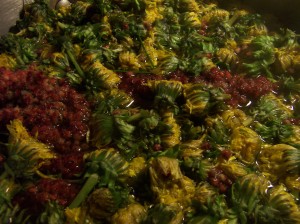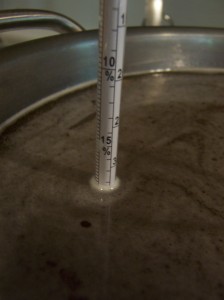
I enjoyed working with the Dandelion Mead last year. I was inspired by the traditional Dandelion Wine, and sure enough, my Dandelion Mead had a unique, if mellow flavor. Last year, I got the Dandelions from a friend, who harvested them for me from his yard.
This year, I wanted to go next-level by harvesting the dandelions myself. I got most of the flowers in my yard today, but only had a tiny fraction of what I needed. As I was going around my neighborhood looking for dandelions, I saw that most of the dandelions had gone to the seedhead stage (white puffballs), whereas I was looking for the yellow flowers. When the sunlight hit the air just right, you could see the airborne seeds, like dust particles in a ray of light coming through the window.
Finally, I saw a small south-facing hillside that still had some dandelions in yellow bloom. I pulled over and harvested a gallon of them:

Then, I tossed two sumac drupes from last year’s harvest into the container of dandelions, and put 2 gallons of water to boil. Once it was boiling, I dumped in the dandelion tops and the sumac drupes, let it boil for a few minutes longer, then turned off the heat to allow the infusion to cool overnight.
The next day, I strained the tea, and it smelled amazing! We tasted it and it was fantastic. My wife said, “I could drink this as my morning tea every day. Very nice!”
Also, when I got a gallon of honey I’d been storing, I was thrilled to discover it was raspberry honey! This is by far the best honey my supplier has available, and it’s probably the best honey I’ve ever had. The honey itself has almost a tartness to it that is utterly delicious. He calls it raspberry honey because the bees that produce it are near raspberry patches, and the flavor from the raspberries comes through. This is one of my favorite examples of how the qualities of the honey produced are a direct result of the ecosystem where the honey was produced. Honey truly is the lifeblood of an ecosystem.
I added enough of the honey to get up to about 19% alcohol potential:
I pitched the yeast, added everything to the carboy, mixed it, and airlocked it, and am left with a beautiful carboy of what will be a wonderful mead:
Truly a springtime brew! We’ll be enjoying this later in the summer.
UPDATE: 15 August
Just racked this mead… it’s already starting to clear! It measures in at 3% alcohol potential, which means this is a semisweet mead at 16% ABV. This will age beautifully, and is already bold and crisp.



